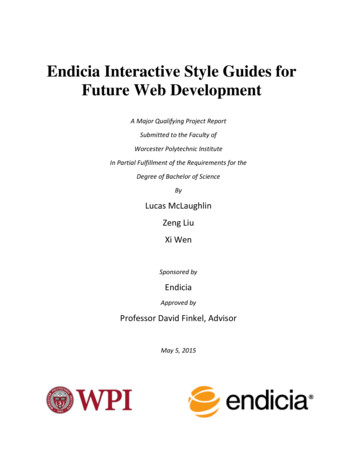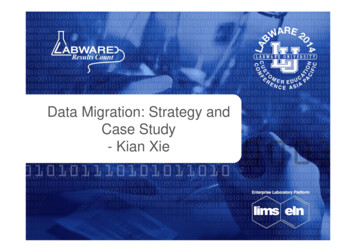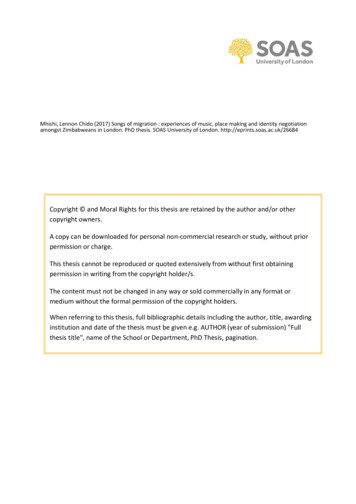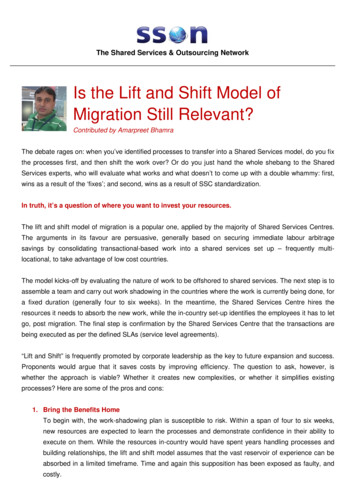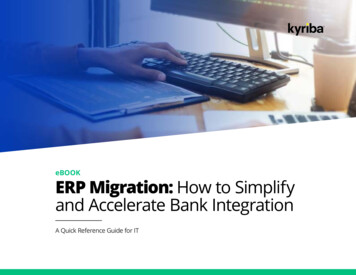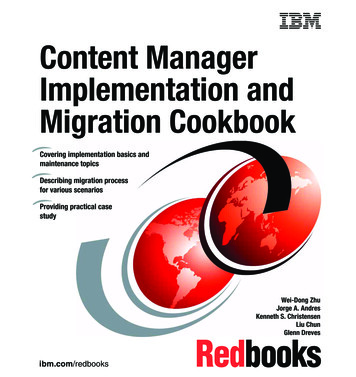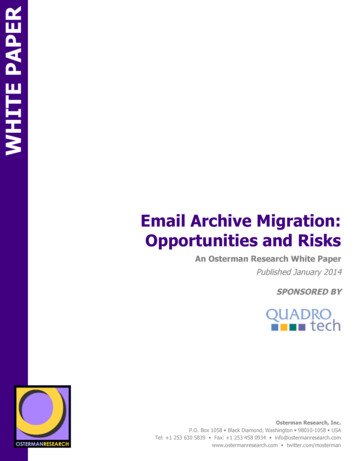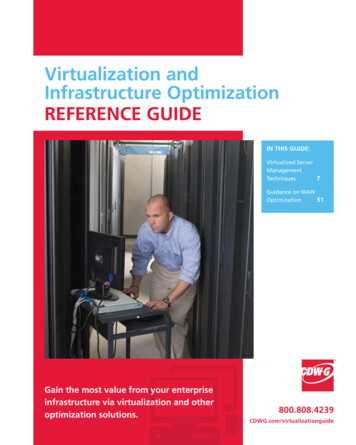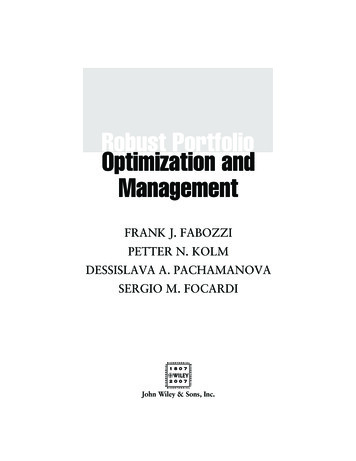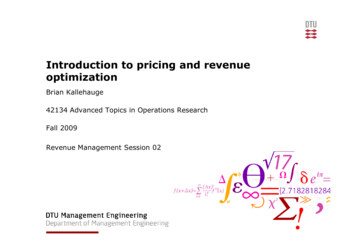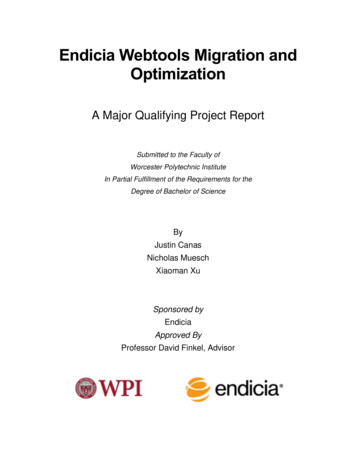
Transcription
Endicia Webtools Migration andOptimizationA Major Qualifying Project ReportSubmitted to the Faculty ofWorcester Polytechnic InstituteIn Partial Fulfillment of the Requirements for theDegree of Bachelor of ScienceByJustin CanasNicholas MueschXiaoman XuSponsored byEndiciaApproved ByProfessor David Finkel, Advisor
AcknowledgementsWe would like to thank the following individuals for their support and assistancethroughout this project:Patrick Farry, ManagerHarry Whitehouse, CTOSanjaya Nepak, MentorUnited States Postal Service WebTools TeamAll of EndiciaProfessor David Finkel, WPI
Table of ContentsAcknowledgements . iAbstract . 1Chapter 1 Introduction . 2Chapter 2 Background . 4Section 2.1 PSI Associates . 4Section 2.2 Endicia . 4Section 2.3 Dial-A-Zip . 5Section 2.4 DAZzle . 5Section 2.5 Endicia Label Server . 5Chapter 3 Requirements . 7Section 3.1 Performance Requirements . 7Section 3.2 Business Requirements . 8Chapter 4 Approach/Methodology . 9Section 4.1 Core Application Tools . 9Section 4.1.1 JBoss Drools . 9Section 4.1.2 Embedded Jetty . 10Section 4.1.3 Web Service Frameworks . 10Section 4.1.4 NGINX . 12Section 4.2 Deployment Tools . 13Section 4.2.1 Apache Maven . 13Section 4.2.2 Docker . 14Section 4.3 Helper Tools . 14Section 4.3.1 Object Aid . 14Section 4.3.2 JMeter & RestEasy Client . 15Section 4.3.3 JProfiler & JConsole . 15Section 4.3.4 Java Management Extensions . 16Section 4.4 USPS Database . 16Section 4.5 ATF File Usage Example . 16Section 4.6 Algorithm Example . 18Section 4.7 Architecture Design . 21ii
Section 4.8 Updating and Quality Testing . 24Section 4.9 Testing Methodology . 24Section 4.10 Deployment . 25Chapter 5 Implementation Details . 27Section 5.1 USPS Interface . 27Section 5.1.1 Using the current webtools API . 27Section 5.2 New API Details . 28Section 5.2.1 Input . 28Section 5.2.2 Output . 32Section 5.3 Code Structure . 35Section 5.3.1 Endicia SLA Requirement - Database Design . 35Section 5.3.2 Algorithm Flowchart Implementation . 37Section 5.4 Error Handling . 40Chapter 6 Optimization. 41Section 6.1 Caching . 41Section 6.2 JVM Tuning . 42Section 6.3 Linux Tuning . 44Chapter 7 Results. 46Chapter 8 Conclusion . 56Section 8.1 Future Works. 57References . 58Appendix A (Users’ Documentation) . 60Appendix B (Maintainers’ Documentation) . 67iii
AbstractThis project worked with Endicia to bring an external United States PostalService system into Endicia’s environment. The system is used to calculate dataneeded to print shipping labels for packages. We built a full-stack server-to-databaseapplication that interfaces with Endicia’s services. We received requirements toprioritize performance and to handle hundreds of requests per second while neverincurring downtime. Through this project, we made this service’s response times 30xfaster. The program was then handed off for deployment.
Chapter 1 IntroductionSending and receiving postage has been a major part of the United States forcenturies. According to statistics released by the United States Postal Service (USPS)for 2014, approximately 5,935 mail pieces were processed each second, satisfying 500million online customers for 2014. [23][24] With the amount of people using technologyin this day and age, speed and scale are always factors to consider when developingsoftware solutions. With such a large demand for shipping mail, many companies havemade it their mission to make the overall process a more efficient one. This necessityfor speed is why the eCommerce company Endicia created this project for our team.Endicia works closely with the USPS to allow businesses to ship mail in a fastand affordable manner. Endicia’s customers are numerous, and the company satisfiesaround 300 requests per second to print shipping labels. The goal of this project was toincrease the performance and reliability of this shipping process. In the previous Endiciasystem, every request to print a shipping label would have to go to an external USPSserver and wait for the server to calculate and output the delivery date. The physicallocation of the USPS server was far enough to cause response times to beunacceptably slow, and the system itself had some inefficiencies such as calculatingunnecessary data for legacy requests. In addition to the slow performance, internalEndicia systems relied upon this slow response from an external USPS server, whichresulted in unreliability for Endicia’s customers. To increase performance and reliability,Endicia asked us to create a localized version of the USPS system.Chapter 2 outlines the history of Endicia and the core features and services theyprovide to their clients. Chapter 3 illustrates the requirements of our project as well asits importance to Endicia. Chapter 4 details the tools used in our application as well asthe architecture of the application. Chapter 5 discusses some of the specificimplementation details made in the codebase of the application. In Chapter 6, wediscuss the optimizations made to both the program as well as the environment onwhich it is deployed to improve performance. Chapter 7 outlines the performance resultsof the application. Chapter 8 details the conclusion and future works from this project.2
Appendix A displays the documentation written for users of our application. Appendix Billustrates how to maintain our application’s codebase after we leave Endicia.3
Chapter 2 BackgroundThis chapter focuses on the history of Endicia, as well as some of their coreservices and programs.Section 2.1 PSI AssociatesIn 1982, a company known as PSI Associates was founded as a technologyconsulting company. One of their first customers was the United States Postal Service(USPS). Over the course of a few years, PSI analyzed the energy consumption of theUSPS and assisted in creating hardware to make USPS services more efficient. Theirfirst big contract with USPS was to create the Postal Numeric Encoding Technique(POSTNET) System. This would allow them to print a barcode on an envelope to sortmail in an efficient manner. After years of working with USPS, PSI Associates wastasked with solving the problem of address cleansing. To accomplish this PSI createdtheir first software solution, Envelope Manager, in 1989. Due to this, PSI Associatesrebranded to Endicia Internet Postage and continued to create innovative softwaresolutions. [9]Section 2.2 EndiciaEndicia and PSI Associates shared the same core goals, making shipping andmailing an easier and more efficient process for businesses. All of their programs andservices are geared towards allowing businesses to create and print postage for all oftheir mailing needs. Some examples of these products are Dial-A-Zip and the EnvelopeManager. Two of Endicia’s biggest services are DAZzle and the Endicia Label Server(ELS), which allows businesses to design, purchase, and print shipping labels [15].These services are discusses in more detail in Sections 2.4 and 2.5 respectively. Todate, Endicia has made over 14 billion in postage printed [9] making them one of thelargest eCommerce shipping companies. On November 18th 2015, Endicia’s primarycompetition, Stamps.com, finalized the 215 million acquisition of Endicia [21]. Despite4
this acquisition, Endicia is still focused on helping make the shipping process easier formany businesses.Section 2.3 Dial-A-ZipOne of PSI’s first software creations was Dial-A-Zip. Dial-A-Zip was created byPSI Associates in the 1990s to solve the problem of obtaining Zip 4 addresses. Prior tothe PSI solution this had to be done manually, making it a lengthy process. Thissoftware was “the first remote address verification system” [10]. In less than onesecond, PSI’s Dial-A-Zip software can correct and subsequently validate any zip codeagainst the Postal Service’s list of addresses [15]. All of this is necessary to do prior toprinting any shipping label. Dial-A-Zip is still a core feature of Endicia’s services.Section 2.4 DAZzleDAZzle is a software product created by Endicia to allow customers to design ashipping label, print that label, track shipments and integrate with online marketplaces.There are “Quick Print”, “Design”, “Address Book” and “Postage Log” tabs in the DAZzlesoftware. “Quick Print” allows users to enter origin and destination addresses, select thedesired mail service, and add insurance value to their packages. After a user chooses amail class, a preview of the shipping label will be created. If the user would like to createa customized label or envelope, he or she can go to the “Design” tab. “This section isgeared toward more advanced label creation and allows users to adjust fonts,alignment, postage options, and more.” [11] Once the design phase is complete, usersare ready to print the label. [7]Section 2.5 Endicia Label ServerEndicia Label Server (ELS) API is a web service that provides functionalitiessuch as printing postage labels, calculating postage rates, buying postages and so on.Most of these features are also available in DAZzle mentioned in section 1.4. However,unlike DAZzle, which is a software product, the ELS API allows Endicia’s customers todevelop their own applications to offer their users USPS shipping without forcing end5
users to install new software or change workflow. Since the API is operating systemindependent, customers do not have to worry about the compatibility problem indevelopment. [12] This API is where we fit in. This project is intended to increase theperformance and decrease overhead of the ELS API, by creating the local equivalentservice that USPS currently provides for Endicia.6
Chapter 3 RequirementsEndicia currently interfaces to a United States Postal Service (USPS) WebService to receive service commitments for parcel shipments. A service commitment isinformation about a package or item being shipped such as its estimated delivery timeand type of package. The aforementioned external interface with USPS is relativelyslow and unreliable. This unreliability is because whenever a query about a packagecomes in, Endicia as a client has to forward the request to USPS Web service and waitfor the response. Such communication takes around 200-300 milliseconds and isextremely unreliable as it depends on the server in USPS being up at all times. EndiciaeCommerce customers expect faster performance and more dependability. Theobjective for our project is establishing an Endicia equivalent service by bringing theUSPS data into the Endicia environment and keeping it current via data files providedby the USPS. With the data files downloaded, we can develop a program that calculatesthe estimated delivery time within a server local to Endicia so that Endicia no longerrequires forwarding a request to an external USPS server. Internal interfaces would alsobe built for various Endicia products to utilize the localized server, making theexperience more efficient and reliable for customers. Essentially, the local server wouldbe a faster, more reliable building block for other Endicia products which requireinformation from USPS.Currently, no company has a localized equivalent of the aforementioned USPSservice, as Endicia is the first company to attempt to implement such a system. Assuch, creating this system demanded a necessity to communicate with various USPSdevelopers and iterate through a first version of algorithm and calculation specifics.Section 3.1 Performance RequirementsThe current use of a USPS Web Service by Endicia causes unreliability and slowperformance of some of Endicia’s core services. The slow performance is primarily dueto the fact that the Endicia server, the one sending a request, is located geographically7
far from the server that hosts the USPS Web Service. The physical distance causes thevariability of network latency to be introduced into each request’s performance. Creatinga localized server that can be used by Endicia’s core services eliminates that networklatency as these servers will be hosted on the same network as the services which ourprogram provides information to.Using the current architecture of sending a request to the external USPS server,each request takes upwards of around 200 milliseconds. After creating a localizedversion of this server, we have a goal of between 10-50 milliseconds per request. Thisallows Endicia’s clients to both receive responses at a faster rate as well as send morerequests in the same amount of time. Another business requirement of this localizedserver is to be able to accommodate between 50-200 requests per second, as set forthby Endicia.Section 3.2 Business RequirementsEndicia has a service level agreement (SLA) with their clients that for all of theirsystems, Endicia can only experience 5 seconds of downtime per year. This SLAbecomes more difficult to accommodate when Endicia has to rely on third party servers.Hosting their own version of the USPS service allows Endicia to more easily fix andcontrol any errors that may arise and ultimately reduce downtime of their own services.The localized service we created also requires the use of data files provided bythe USPS. These files are updated once a week. To provide Endicia’s clients with themost up to date data, we had to create a means of updating the data files our programuses on a weekly basis. Since Endicia has the SLA of no more than 5 seconds ofdowntime a year, careful planning and designing was done in advance to ensure wecan update the programs files without shutting down the program. Details on how this isimplemented can be found in Section 5.3.1.8
Chapter 4 Approach/MethodologyThis Chapter focuses on the overall methodology for our project. Section 4.1discusses the tools that we used in developing the core application. Section 4.2 outlinesthe tools we used in deploying the core application into a production environment.Section 4.3 describes the tools we used in debugging and testing the core application.Sections 4.4 and 4.5 discuss the USPS database and the accompanying files. Section4.6 walks through an example of one of the USPS algorithms that our program uses tocalculate package information. Section 4.7 discusses the architecture of the coreapplication. Finally, the remainder of the chapter goes over the deployment phase of theapplication.Section 4.1 Core Application ToolsThis section outlines the tools that we used to create the core application. Thesetools are necessary for the deployment and development lifecycles.Section 4.1.1 JBoss DroolsJBoss Drools is a business rules management system (BRMS) created bydeveloper Red Hat [3] Using a Java like syntax, a business can utilize JBoss Drools tospecify a set of rules for validating and manipulating Java Objects. This is useful forcomparing a set of data against some known business facts and then manipulate thedata accordingly.Figure 1: Example of a Drools Rule9
Figure 1 displays an example of a rule validating a holiday object. In this codefragment, the fact h1 (in this case the fact is a holiday object) is verified to have itsmonth attribute equal to “july”. If the holiday input object has the month of July, the “if”block will evaluate to true and the “when” block will execute, ultimately printing astatement. If the holiday input object has any other month, then the “when” block will notexecute and no more code will be executed.In the program we developed for this project, JBoss Drools is used to update auser’s shipping label information based on specific rules specified by the United StatesPostal Service. This inc
Endicia Label Server (ELS) API is a web service that provides functionalities such as printing postage labels, calculating postage rates, buying postages and so on. Most of these features are also available in DAZzle mentioned in section 1.4. However, unlike DAZzle, which is a software product, t
